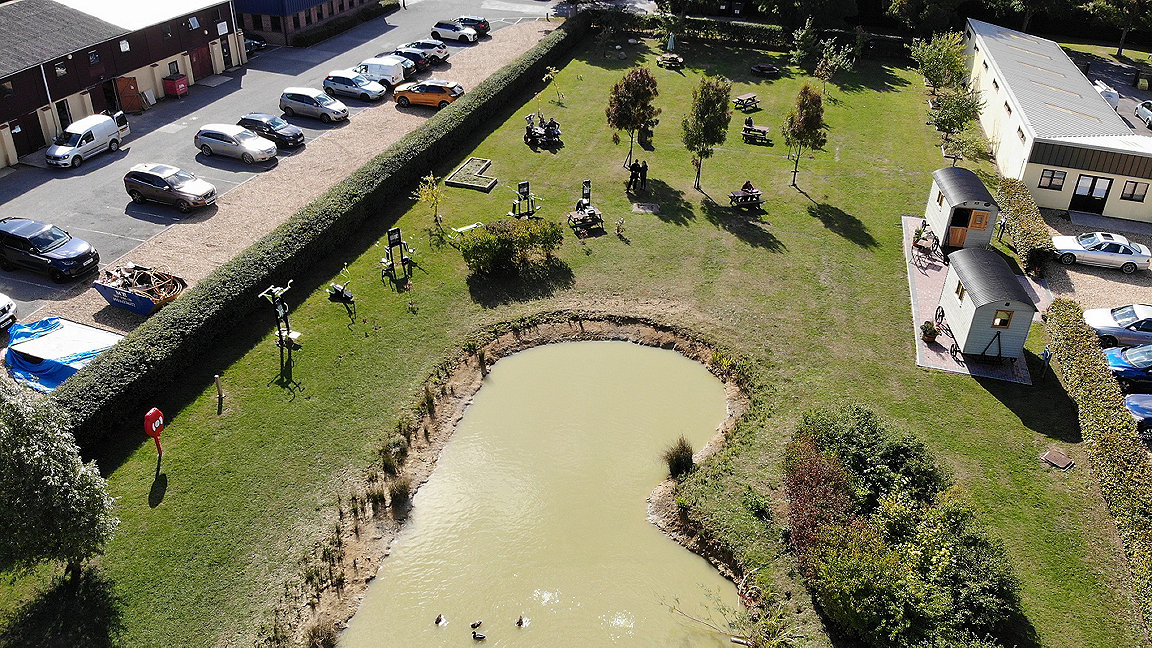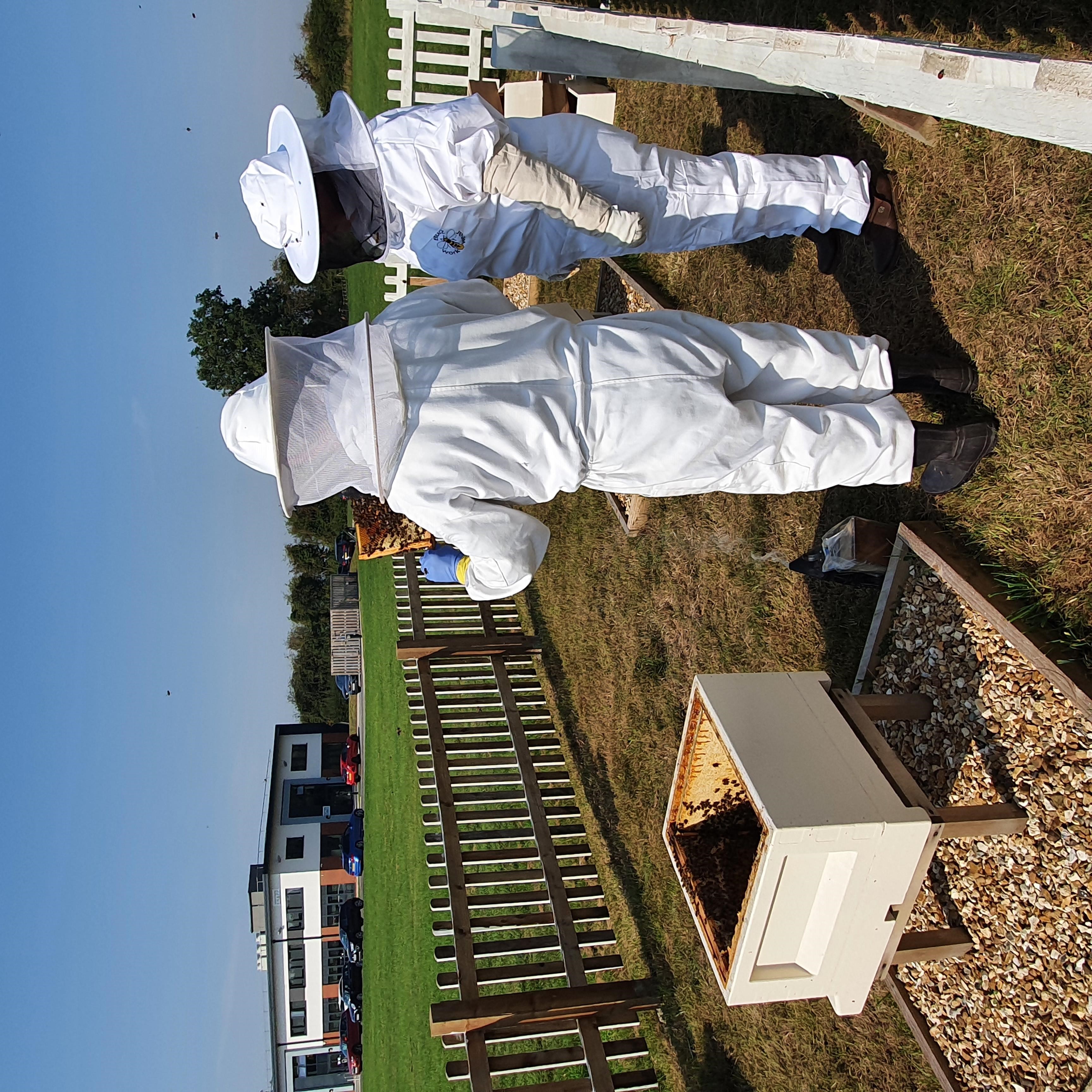
The lake and outdoor gym at Monument Park assist physical and mental well-being © Jennings of Garsington Ltd
Property Journal: What is Jennings' Monument business park?
Chris Williams: Jennings is a family business that owns and manages Monument Park in Chalgrove, South Oxfordshire. Originally a poultry farm, we've developed and grown into a business park over the past 40 years.
Most of the older buildings on the site have been replaced and expanded, so we now have a range of modern workshops, business units and serviced offices that are home to around 100 tenant businesses, with more 500 people working here.
The majority of our tenants are owner-managed SMEs. Each typically has ten to 15 employees, covering a broad range of industries from food production to 3D printer manufacture, web design to marketing and tech engineering.
We've always been a values-led business, and are passionate about preserving our beautiful environment, as well as fostering good relationships. We've worked to build a friendly community on the park and we encourage everyone to know their neighbour and use the services or products each of them offers.
Being in a rural area, we recognise some homeworkers and home-based enterprises can feel disconnected or isolated, from other business owners and the wider economy, so we host networking events and educational workshops to help bring local businesses together. We also organise social events such as barbecues and bowling nights so everyone can relax and feel the benefits of this community.
This works as a business model too – several of our tenants have stayed with us for more than 30 years as they've grown and developed.
PJ: Why did you embark on attaining net-zero carbon?
CW: Sustainability has always been factored in to the design of Monument Park, even in its early stages. We're in a wonderful countryside setting and we wanted the park to reflect that.
Although we have plenty of workspaces, we've also kept many green spaces with lawns, trees and hedgerows and a lake area, so people who work here can enjoy time outside. Any new buildings are always designed to be as energy-efficient as possible.
However, we had an epiphany when it came to our sustainability plan. Two years ago, we hosted an eco day to which we invited more than 100 local businesses, charities and environmental experts. It was a great success, and showed there was an appetite for learning more about sustainability.
We asked a group of local schoolchildren to be keynote speakers, and they poignantly described their anxiety and fears for their own future, and how the climate crisis will look when they're middle-aged. This was the moment we wholly realised our responsibility; a duty to be much more proactive about protecting our environment, especially for generations to come.
Achieving net-zero became the next logical step for us as a company. Following that event, we began gathering data on our energy use and water consumption, business travel and commuting, our waste and recycling and the repairs and maintenance we carry out around the business park.
Using 2019 as our baseline year, we set targets to reduce as much as we could the following year; 10% less energy, 20% increase in recycling, 5% less water consumption and urging our maintenance team to think carefully about the materials and machinery they use as well.
With the data collected over two full years we could calculate our greenhouse gas (GHG) emissions and measure the carbon footprint for the company. The GHGs in carbon footprints are split in to three categories, known as Scopes. They were designed in 2001 as part of the greenhouse gas protocol and are now mandatory in a company’s GHG reporting. Scope 1 come from direct emissions, like fuel used for company owned vehicles, Scope 2 come from purchased energy consumed by the business and Scope 3 is a complex area as it includes all emissions from suppliers, materials used, business mileage, staff commuting, water consumption and waste/recycling. Calculating all three scopes is not straightforward, especially scope 3. We opted to hire a local consultant to help us with Scope 3. It added around £700 to the cost of the full assessment but it was very worthwhile. Everyone knows the true value of a qualified expert.
We realised that setting targets had worked and through 2020 we'd reduced our overall emissions by over 30% from the baseline, so reaching a level where offsetting to net zero became sensible and affordable.
Having achieved the targets for Jennings, we decided to set the ambitious goal of creating a totally net-zero business park.
'We realised that setting targets had worked and through 2020 we’d reduced our overall emissions by over 30% from the baseline'
PJ: Why is a roadmap so important for getting to net zero, and what are some of the key features for the business park?
CW: Creating our Roadmap to Net Zero 2030 was possibly one of the hardest steps we've taken so far, but also one of the most rewarding. At first it seemed as though we had a mountain to climb, and there was so much information to decipher, such as how to calculate the emissions for the many deliveries we receive, how do we measure GHGs for the building materials we use and the plant machinery we hire. But like all journeys it had to begin somewhere, and it's much easier if you have a plan and a map to show where you're going.
With help from our own community, we started by setting out a timeline to achieve three main targets: making sure every tenant is using renewable energy; that no waste is sent to landfill; and that we're all reducing our carbon emissions year on year. It then became easier to add in other targets to achieve along the way; recycling on a bigger scale, adding more electric vehicle chargers onsite to make electric vehicle (EV) use easier, reducing delivery miles by buying from local suppliers and encouraging 'localism'.
- energy: reducing consumption and switching to renewable providers, to supplement renewable energy generated on site
- waste: sending none to landfill, reducing single-use products and packaging
- water: reducing consumption, reusing where possible, and providing water bottle refill stations on site
- transport: encouraging and installing infrastructure for electric vehicles, championing car sharing and cycling
- environment: improving wildlife habitats, planting wildflower meadows, increasing use of eco cleaning products
- procurement: sourcing local or sustainable products and services from our supply chains
- community: hosting climate change awareness events for the local community, starting new collaborations and networks connecting like-minded people and involving local businesses in our initiatives to help get them started on their journey
- sustainable decision-making: ensuring decisions are guided by B Corp's triple bottom line model of 'people, planet, profit', giving each equal consideration – the method adopted by all B Corp Certified businesses.
PJ: What is a B Corp, and how can certification help you on your journey?
CW: We're big fans of what the B Corp community stands for. The structure aims for businesses large and small to take responsibility for their actions and be transparent about what they do. The belief is that business should be a force for good and give equal importance to supporting local communities, making decisions that are environmentally sound and looking after staff properly. This all helps to create a much better organisation.
With this in place, however, you can increasingly influence your supply chain and your customers in a positive way. Most people want to buy from ethical, transparent providers, so it also makes good financial sense.
- How do we measure our impact in the community?
- In what ways have we influenced others to be more sustainable?
- How many organisations have we collaborated with and what were the demonstrable outcomes?
- What methods do we use to share information and data with various groups of different stakeholders?
We took learnings from this process, and used it to codify much of what we already do. It helped to crystalise our thinking and become better in our communication too. We introduced new practices, such as introducing social and environmental goals to our staff reviews and creating a 'preferred supplier list' of local providers, in line with their requirements and we updated several internal policies. We involved each member of the team and with their agreement we introduced new job descriptions to reflect our commitment to the environment and the community.
We submitted our application earlier this year and we're now waiting to be fully assessed. We hope to hear good news in the new year.
Being a B Corp will open new doors, allow us to meet like-minded businesses and help us carry on doing what we do, but even better.
We recommend that every business look at the BIA. It's free to download, and just reading through it is a big step in the right direction. No matter how good you think you are, it will be a great lesson.

PJ: What advice would you give to other sites like yours that want to attain net zero?
CW: Try not to think of it, like we did, as a mountain to climb. Break it down into bite-size chunks and look at each area of your organisation separately – energy, waste, water, transport and so on. Pretty soon it will start to make sense: you'll see areas that need more focus and ways to move forwards.
The process has brought about so many benefits for us, with some unexpected ones as well. Not only have we seen a marked increase in interest in what we’re doing from local and national media, but also our tenants are keen to get more involved, our team are more engaged through our sustainability plans and we’re saving on costs too – we saved over £1,200 last year on waste collections alone.
We're happy to share any of the work we've done – our roadmap, our calculations, our contacts – or just have a conversation about what you're trying to do. It may help as a starting point.
Remember: no one can change everything, but everyone can change something. Working together and collaborating is the only way our global community is going to make this happen.
Chris Williams is commercial manager of Jennings of Garsington Ltd
Contact Chris: Email
Related competencies include: Business planning, Sustainability
